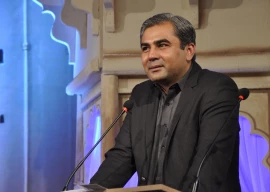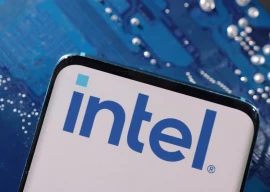
Civil Hospital, Mirpurkhas, and the doctors’ residential quarters that surround it, are a bizarre archipelago in a 13-acre sea of rainwater.
Gulab, a resident of the Digri Tehsil waded through torrents of floodwater to get to the hospital located in the centre of Mirpurkhas City bearing his six-year-old daughter suffering from pneumonia.
Upon reaching the gate, he hired a donkey cart waiting there in order to cross a moat of rain, river and sewerage water only to be told that the hospital is unable to treat chest congestion and he would have to take her to Hyderabad, Lal Batti, instead.
From the main gate to the hospital, the water stands at about five feet, while the floor of the hospital is hidden under a layer of muck.
The ambulances gave way as water soaked into their engines.
A makeshift ramp has been constructed for stretchers and gurneys and a pair of donkey carts have been hired by the hospital to transport their staff inside. The patients, on the other hand, have to pay Rs10 per head for each trip to and from the gate and the hospital. Critical patients - particularly those with heart problems - do not survive the bumpy trip.
Though it is the district’s civil hospital, people from the Tharparkar, Sanghar, Umarkot, Mirpurkhas and Tando Allahyar districts all travel here and about 3,000 patients are treated daily.
Gulab was turned away from the last functioning ward of the hospital that housed a total of 100 people - doctors included.
There are about 1.5 million people living in Mirpurkhas district alone. Like Gulab’s daughter, the majority of patients have to be turned away because the hospital’s supply of medicines and technology has severely been affected. Others simply cannot stomach the filth that fills the wards.
Nearby, there is an area known as New Town where there are about six private medical centres. The queues outside these clinics are longer than those outside ration distribution centres as people line up, prepared to pay private bills for medical attention.
Strangely enough, the road outside is not flooded - roughly 20 days after the rains stopped, only the hospital compound remains flooded. It is one of the areas, including Mirpurkhas, Digri, Diplo and Sanghar, where water remains.
Efforts to drain the civil hospital in Sanghar have been abandoned altogether and an emergency centre in an adjoining shop has been setup to help patients in need of urgent medical care.
Meanwhile, the Mirpurkhas hospital management, taluka municipal administration and district management are too busy pushing the responsibility of draining the hospital off on each other to actually make any headway towards getting the water out.
Their homes flooded and belongings destroyed, even the paramedics and doctors living in the hospital compound have shifted away. Probably the only upside is that the electricity supply is still up and, during load-shedding, the hospital generators are also functioning. Not to be overlooked either is the dedication of the doctors who wait at the gate for patients, working with what little they have.
In the days that have passed since the water flowed down from the saltwater drain to the left of the district, sewerage from the hospital has mixed into the water. The doctors say that the sanitation problem is so bad that they are not even sure what kind of diseases are spreading in the hospital. The most common complaints, after gastroenteritis and malaria, are skin diseases. Swimming through the stew of sewerage, rainwater and mud are fish weighing up to 200 grammes. According to social worker Kanji Dheel, the situation is worsened by certain influential landlords who are draining their agricultural lands and sending the water towards Mirpurkhas City.
with additional writing by husna anwar
Published in The Express Tribune, September 28th, 2011.
COMMENTS (1)
Comments are moderated and generally will be posted if they are on-topic and not abusive.
For more information, please see our Comments FAQ




































Without sounding too much anti Pak, we need to set our priorities right > less on defence, say not more than 2% of GDP will help. And what use atom bums ?